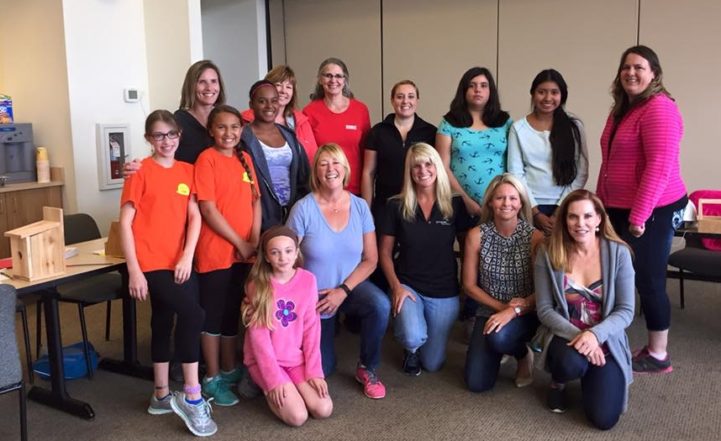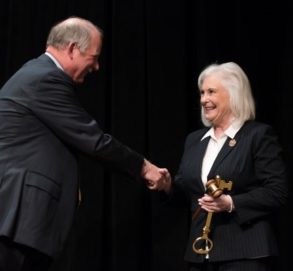
by LIZ EVANS, Northern District manager, AGC of Washington
Today’s construction industry is increasingly sophisticated, with millennials driving much of the change in technology and innovation. One thing not dramatically changing, however, is the number of women entering the industry.
According to a 2014 Bureau of Labor Statistics report, the U.S. construction industry is comprised of 8.9% women. The National Women’s Law Center reports the numbers are even bleaker for women in the field — 2.6% — and that rate has held steady for the past 30 years.
Women bring many valued skills to the table. Women are collaborators, team builders, organizers, networkers and communicators. Women are also technically adept and ready to embrace new ideas.

Cynthia Paul, managing director at FMI, points out that having women on your team is good for business and a reflection of the diversity in construction customers. More clients are looking at the teams you bring to the negotiating table, and diversity is an increasing factor in determining selection.
While most agree that building a diverse workforce is a win-win, the challenge continues to be how to get there.
Patricia Galloway, PE, president of Pegasus Global Holdings in Cle Elum WA, was a recent speaker at the AGC of Washington Annual Convention. [In 2004, she served as the first woman president of the national American Society of Civil Engineers.] Also known online as “Engineer Girl”, Galloway is an advocate for recruiting and retaining more women in engineering and construction.
“When I graduated as a civil engineer in 1978 from Purdue, the percent of women in the engineering workforce was 10%,” she said. “Thirty-six years later, according to the National Science Board’s 2013 Engineering and Scientific Indicators, women only comprise 13% of the engineering workforce.”
Galloway said some of the key reasons women are not finding their way to the industry are lack of female role models, negative industry image, and cultural disconnect.
Finding role models
Interest in construction came early for Kindra Scobba, who spent hours building a Barbie house when she was a girl. “For me, building the house was the fun part,” she said. “I did not really care about playing with it.”
Scobba graduated from the construction management program at Central Washington University, and is starting her career at Mortenson Construction. She would be happy to see more women join her in an industry she loves, but the word “construction” is daunting. “It can be very intimidating,” she said.
Scobba, like many young women in the early stages of their careers, is eager to find other women to align with. “Advice from women that were once in my position is invaluable, and having a support system to reach out to in any situation is something I always want to have,” she said.

Carrie Sturts Dossick, an associate professor in construction management at the University of Washington, said the industry must find different ways to interest women in construction careers.
“Women are socially programmed to be networkers and to make a difference in the world; they want their work to be meaningful and have a social impact,” she said.
As an industry, we have not been very good at telling women how important our industry is to quality of life, sustainability and social impact. Not helping the cause is the lack of industry role models.
“It’s like the chicken and the egg,” Galloway said. “If you don’t promote women into higher levels within the organization, then there will be no role models for young girls.”
Progressive companies are starting to bring women to career fairs and use them in recruitment and retention. “Mortenson is very good about sending women to information sessions when they are recruiting, and that was helpful in making me feel like I could be part of the industry,” Scobba said.

Karen Dorsey, senior project manager at Skanska, said it is important to retain women in the industry and make them feel welcome. Dorsey was a math and science geek early on. A college counselor steered her to engineering, which she chalks up to pure luck.
Throughout her 27 years at Skanska, Dorsey has been a huge supporter of women and a role model. She encourages women to speak up at meetings and find their seat at the table. She is mindful to recognize women’s accomplishments.
“We must market ourselves to women and speak their language,” Dorsey said.
Dorsey is involved in the Skanska Women’s Network, which is an employee resource group focusing on the needs of women. Her advice? Be confident, believe in yourself, don’t apologize, and don’t be afraid to be the smartest person in a room.
Dorsey said it is still a huge hurdle for women to get to the executive level, but the tide is turning.
Work-life balance
The construction culture is rooted in a demanding and relentless focus on schedule — and that can be problematic for women. “The rigid working hour policies and inherent work-life balance issues associated with this culture is a real barrier for women,” Galloway said. “While women have the physical strength to meet the work demands, they may not feel a psychological fit in an industry where they have to sacrifice their ‘woman’ identity.”
“There is plenty of room for women to excel in today’s high-tech construction industry, but we need to do a much better job of telling our story”
The industry challenge is to take a different look at how to create an environment where women can thrive through their careers. Galloway stresses that if we are to be successful in attracting and retaining women to the industry, three areas must be addressed: career advocacy, female role models and work-life integration. “The bottom line is there is plenty of room for women to excel in today’s high-tech construction industry, but we need to do a much better job of telling our story,” she said.

This week is National Women in Construction Week, and women around the country will gather to inspire, celebrate and support the role of women in the industry. Locally, organizations such as the National Association of Women in Construction (NAWIC) and Women Leaders in Construction are excellent resources for women to gather and learn from each other.
In January, AGC of Washington welcomed its first woman president, Nancy Munro of MidMountain Contractors. It was a proud moment for Munro, who told the crowd, “I may be the first woman president of the AGC, but I won’t be the last!”

Based in Seattle, the author is Northern District manager for AGC of Washington, and a board member of NAWIC. She is a certified association executive (CAE). Follow her on Twitter @levans1971. This article first appeared March 3 in the Seattle Daily Journal of Commerce.

Discussion
Be the first to leave a comment.
You must be a member of the BuiltWorlds community to join the discussion.